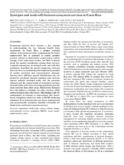| dc.description.abstract | Ecosystems services have become a key concept
in understanding the way humans benefit from
ecosystems. In Costa Rica, a pioneer national
scheme of payment provides compensation for forest
conservation that is assumed to jointly produce
services related to biodiversity conservation, carbon
storage, water and scenic beauty, but little is known
about the spatial correlations among these services.
A spatial assessment, at national scale and with fine
resolution, identified the spatial congruence between
these services, by considering the biophysical potential
of service provision and socioeconomic demand.
Services have different spatial distributions but are
positively correlated. Spatial synergies exist between
current policies (national parks and the payment
scheme) and the conservation of ecosystem services:
national parks and areas receiving payments provide
more services than other areas. Biodiversity hotspots
have the highest co-benefits for other services, while
carbon hotspots have the lowest. This finding calls for
cautiousness in relation to expectations that forestbased
mitigation initiatives such as REDD (reducing
emissions from deforestation and forest degradation)
can automatically maximize bundled co-benefits for
biodiversity and local ecosystem services. | es_ES |


